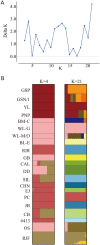Genetic diversity of 21 experimental chicken lines with diverse origins and genetic backgrounds
- PMID: 30542001
- PMCID: PMC6511517
- DOI: 10.1538/expanim.18-0139
Genetic diversity of 21 experimental chicken lines with diverse origins and genetic backgrounds
Abstract
The genetic characteristics and diversity of 21 experimental chicken lines registered with the National BioResource Project of Japan were examined using mitochondrial D-loop sequences and 54 microsatellite DNA markers. A total of 12 haplotypes were detected in the 500-bp mitochondrial DNA sequences of the hypervariable segment I for 349 individuals of 21 lines. The 12 haplotypes belonged to three (A, D, and E) haplogroups, out of the eight (A‒H) common haplogroups in domestic chickens and red junglefowls. The haplogroups A and D were widely represented in indigenous chickens in the Asian and Pacific regions, and the haplogroup E was the most prevalent in domestic chickens. Genetic clustering by discriminant analysis of principal components with microsatellite markers divided 681 individuals of 21 lines into three groups that consisted of Fayoumi-, European-, and Asian- derived lines. In each of the cladograms constructed with Nei's genetic distances based on allele frequencies and the membership coefficients provided by STRUCTURE and with the genetic distance based on the proportion of shared alleles, the genetic relationships coincided well with the breeding histories of the lines. Microsatellite markers showed remarkably lower genetic heterozygosities (less than 0.1 observed heterozygosity) for eight lines (GSP, GSN/1, YL, PNP, BM-C, WL-G, BL-E, and #413), which have been maintained as closed colonies for more than 40 years (except for #413), indicating their usefulness as experimental chicken lines in laboratory animal science research.
Keywords: chicken bioresource; genetic diversity; microsatellite DNA marker; mitochondrial DNA.
Figures




References
-
- Chang C.S., Chen C.F., Berthouly-Salazar C., Chazara O., Lee Y.P., Chang C.M., Chang K.H., Bed’Hom B., Tixier-Boichard M.2012. A global analysis of molecular markers and phenotypic traits in local chicken breeds in Taiwan. Anim. Genet. 43: 172–182. doi: 10.1111/j.1365-2052.2011.02226.x - DOI - PubMed
MeSH terms
Substances
LinkOut - more resources
Full Text Sources
Research Materials
Miscellaneous

